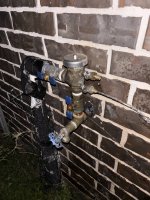I was opening the pool back flow preventer after it was winterized that is connected to an outside spigot (it was existing before pool was built) when I discovered a pin hole leak in the pipe threading coming out of the house. it is not copper or Pex or any other common material used for supply lines. My guess is it is galvaniced steel, but not really sure.
I will use plumbing Epoxy for a temp fix, but can't really figure out how to replace this pipe, how it is connected inside the wall and the pipe material to use so it can support the weight and does not rust like this pipe and can withstand freezing. The house is on slab so no basement or crawl space, this rusted pipe is only 4 years old. any advice is appreciated.
I will use plumbing Epoxy for a temp fix, but can't really figure out how to replace this pipe, how it is connected inside the wall and the pipe material to use so it can support the weight and does not rust like this pipe and can withstand freezing. The house is on slab so no basement or crawl space, this rusted pipe is only 4 years old. any advice is appreciated.






